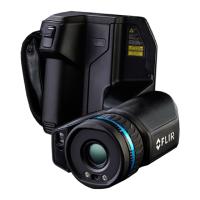Quick start guide
5
5.1 Procedure
Follow this procedure:
1. Before starting the camera for the first time, charge the battery for 3 hours using the
stand-alone battery charger.
2. Put the battery into the camera battery compartment.
3. Insert a memory card into the card slot.
Note Empty or use a memory card that has not previously been used in another type
of camera. The cameras may organize files differently on the memory card. There is
therefore a risk of losing data if the same memory card is used in different types of
cameras.
4. Push the on/off button
to turn on the camera.
5. Aim the camera toward the object of interest.
6. Adjust the infrared camera focus.
Note It is very important to adjust the focus correctly. Incorrect focus adjustment af-
fects how the image modes work. It also affects the temperature measurement.
7. Push the Save button to save an image.
8. Download and install FLIR Tools/Tools+ or FLIR Report Studio on your computer.
1
9. Start FLIR Tools/Tools+ or FLIR Report Studio.
10. Connect the camera to the computer using the USB cable.
11. Import the images into FLIR Tools/Tools+ or FLIR Report Studio and create an inspec-
tion report.
12. Send the inspection report to your client.
5.2 To keep in mind
• Adjust the focus first. When the camera is out of focus, the measurement will be wrong.
• By default, most cameras adapt the scale automatically. Use this mode first, but do not
hesitate to set the scale manually.
• A thermal camera has a resolution limit. This depends on the size of the detector, the
lens, and the distance to the target. Use the center of the spot tool as a guide to the
minimum possible object size, and get closer if necessary. Make sure to stay away from
dangerous areas and live electrical components.
• Be careful when holding the camera perpendicular to the target. Be observant of reflec-
tions, especially at low emissivities—you, the camera, or the surroundings may become
the main source of reflection.
• Select a zone of high emissivity, e.g., an area with a matte surface, to perform a
measurement.
• Blank objects, i.e., those with low emissivities, may appear warm or cold in the camera,
because they mainly reflect the environment.
• Avoid direct sunlight on the details that you are inspecting.
• Various types of faults, e.g., those in a building’s construction, may result in the same
type of thermal pattern.
• Correctly analyzing an infrared image requires professional knowledge about the
application.
#T810253; r. AA/42549/42549; en-US
11
1. FLIR Tools+ and FLIR Report studio are licensed software.

